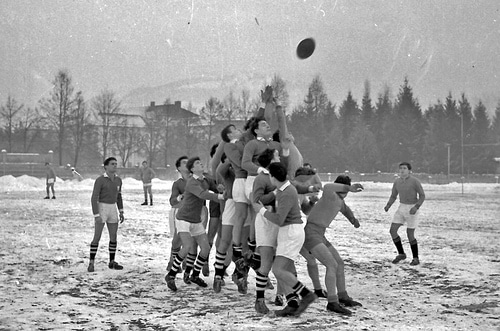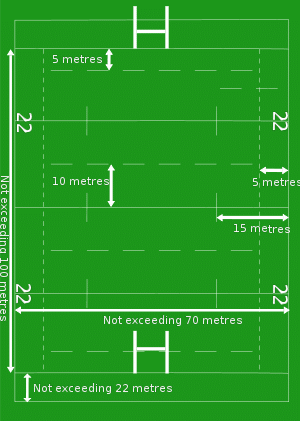
Rugby as it exists today is one of the most exciting contact sports in existence, a perfect mix of the speed and movement of soccer and the hard hitting physical nature of American football. The Rugby World cup is the third most watched sporting event in the world, trailing close behind the FIFA World Cup and the Summer Olympics. While Americans love our football, the rest of the world loves their rugby. Indeed, the 2003 World Cup had a collective audience of over 3.5 billion, and was broadcast in 205 different countries. Maybe it’s time we Americans see what all the fuss is about…
The following will serve as a basic introduction to the game of rugby, from the history of the game to its objectives and main rules, and will also have some tips on where you can find opportunities to play yourself.
Before going into the details on how to play rugby, a distinction should be made as to what kind of rugby we’re talking about here. There are two main styles of play, known as Rugby Union and Rugby League. While they have many similarities, they are essentially very different games. This article will focus on Rugby Union, which is the more prominent of the two.
Field and Equipment
A rugby ball is most similar to an American football in size and shape, although it is larger and most modern versions have no laces.

As far as personal equipment goes, there really isn’t much. A mouthpiece is mandatory in regulation play, and there is an optional soft-padded head gear known as a scrum cap, the main purpose of which is the protection of the pack player’s ears in the scrum. Scrum caps are very similar to the old leather helmets of American football.
Known as the pitch, a rugby playing field is a large grassy surface 100 meters long and 70 meters wide with uprights on each end. Behind the uprights is the goal area, which has to be 10 meters deep at minimum and is usually 22 meters in depth. Line markings are illustrated in the diagram below.

Players and Positions
Two teams are represented on the pitch, with 15 players per side. The players on a team are broken down into two separate groupings, the pack and the backs.
Generally speaking, the pack consists of larger, more physical players who are equivalent to defensive lineman in American football. The backs are usually the faster, more maneuverable players comparable to the backfield and receivers in American football. Jersey numbers 1-8 represent pack players, and 9-15 are the backs. The diagram below illustrates the breakdown of the fifteen separate positions on the field of play:

Game Play
Rugby game play is not terribly complicated; however, it is extremely confusing to many who are unfamiliar with the game. This can be attributed to the fact that while it does share similarities with other sports, it is vastly different from the other games we try to compare it to (namely soccer and American football). Unlike soccer, carrying the ball is legal, which in many ways makes it more similar to football. However, unlike football, there are no forward passes allowed in rugby, and match play is only stopped for penalties, not between every play.
A regulation length match lasts for 80 minutes broken down into two 40 minute halves with a 10 minute break during halftime. The clock constantly runs and play only stops during the match for penalties. Essentially, the average rugby player is constantly in motion varying between jog and all out sprint. For that reason, rugby demands a high level of physical fitness, and you’re probably not going to see many of these guys on the field:

Objective of the Game
The objective of rugby is to score goals, known as a try, by touching down the ball inside the opposing team’s end zone. Any player may carry the ball and is capable of scoring. A try is worth 5 points, after which a conversion kick is awarded, allowing for the chance to score 2 additional points if successful. There are also other means of scoring, the first being a drop goal. This occurs when a player kicks the ball through the opposing team’s uprights during play, and is worth 3 points. In order for the drop goal to count, the ball must make contact with the ground before being kicked (essentially dropped then kicked, making it a difficult maneuver). A penalty kick can also be granted for certain penalties, allowing for a free kick from the site of the infraction (as long as it is behind the 22 meter line). The penalty kick is also worth 3 points.
So how do teams go about scoring? There are various elements that occur during play after certain events. By following along with an imaginary scenario of how a match might progress, we can analyze these elements.
Kickoff
At the start of the match and immediately following halftime, there is a kickoff from the 50 meter line. Who kicks off is decided by a coin toss before match play begins. A kickoff also occurs after a team scores a try. This is another area where rugby differs from American football; rugby is “make it, take it,†with the scoring team receiving the following kickoff.
Ball Movement
Upon receiving the kick, players will attempt to advance the ball up the field either by running, passing, or kicking. Any player can run the ball; however, teammates are not allowed to block defenders from tackling the ball carrier, and it is illegal to use your teammates as a shield when carrying the ball. Passing is allowed, but only in the form of a reverse lateral, meaning that the player you are passing to must be behind you on the field of play. Laterals and forward laterals result in penalties. Finally, it is sometimes advantageous for the ball carrier to kick the ball over the defense, allowing himself or another teammate to run it down or receive it (it is acceptable to receive your own or a teammate’s kick).
The Ruck
Let’s assume at this point that the ball carrier is tackled by the defense. What forms out of this is known as the ruck. While being tackled, the ball carrier will attempt to roll so that his back is facing the defense and will shield the ball with his body. All this must be simultaneous with the tackle, as a player on the ground is not allowed to guard or handle the ball at all with their hands. While the tackled player is shielding the ball, pack players from his team (usually 2 or 3) will move over him in an attempt to keep the defense away from the ball, which anyone can take at this point. Assuming the defense has not recovered the ball, another offensive player, usually the scrum half, will come in, retrieve the ball, and pass it out to the backs, allowing play to continue.
The Scrum
As play continues, let’s assume there is a penalty. Depending on the violation, the opposing team is presented with options from the official. Many penalties result in the other team being awarded a scrum. A scrum is the most recognizable of the rugby formations, and you have likely seen pictures of it before. It is a set play in which both team’s pack players bind themselves together to form three rows each (3 men, then 4 men, then 1 man). With both teams having created this formation, the two masses face each other and lock shoulder, with a tunnel naturally being created between the front rows. At the official’s signal, the two teams drive against each other and the ball is thrown into the tunnel by the offensive scrum half. The object is then to drive the opposite team off the ball, carrying the ball underneath your own team (no hands allowed) and into the hands of the scrum half, who is now there awaiting it. Assuming this is successful, the ball is the passed out to the backs and play continues. The scrum is generally a very rough place, and is most likely the inspiration of Ralph Waldo Emerson when he wrote:
“Whoso would be a man, must be a non-conformist, and preferably play in the pack.”
A fine example of a scrum:
The Line-Out
As play continues, a ball carrier is tackled out of bounds, known in rugby as into touch. At this point play stops, and the opposing team is awarded a line-out. In a line-out, an offensive player throws the ball above a tunnel formed by the opposing teams, and the lifters lift jumpers up in the air in an effort to grab the ball before the other team does. The lifters and jumpers must be members of the pack. The offensive team has the advantage in that they decide how many players will participate in the line-out, and the defense can only use an equal amount or less. Also, the offense usually employs strategy, with the player tossing the ball at a certain height and distance unknown to the defense. The ball must be thrown in straight above the tunnel so as to give both teams a legitimate chance of taking possession. Once in possession of the ball, the jumper either passes the ball down to the scrum half or is lowered down and hands it off to the scrum half, and play continues.
An example of the line-out:
The Maul
By now the team with the ball is threatening to score. A player receives a pass and drives through several defenders, drawing very near to the try zone. Before he can enter and touch down the ball, however, he is hit by several defenders. But instead of going to the ground, he retains his footing, turning his back on the defenders who are attempting to tackle him and starts effectively shielding the ball. What is happening can now be referred to as a maul. Essentially, a maul is a standing, mobile version of a ruck. Offensive pack players will now rush in and bind onto the ball carrier, driving him forward in an effort to continue to gain ground. While it is illegal once a maul has begun for the ball carrier to ground the ball, he can hand it off to another player. Usually the scrum half will take the ball from him and pass it off to the backs so that play can continue.
Scoring a Try and the Conversion
The ball has been passed out of the maul and is in the hands of one of the backs, who carries it into the try zone and touches it down, scoring five points for his team. The ball must be touched down in order for points to be awarded. It is also important to consider where the ball is touched down, as the conversion kick is kicked from the same spot on the 22 meter line (or closer/farther back if the kicker chooses). So, if a player scores a try by touching the ball down in the far right corner of the try zone, the ball will be set up even with that point on the 22 meter line for the conversion, making the kicker’s job considerably harder.
Penalties
As this is only an introduction, I won’t go into detail on the various penalties too much, but here is a list of some major ones to keep in mind:
- No forward or lateral passing.
- A dropped pass is known as a knock on, and results in a penalty.
- No tackling an airborne player.
- No tackling by the neck.
- When a ball is kicked, any offensive player ahead of the kicker on the field is considered off sides and may not participate in play until the kicker has advanced past him. Participating in play after a kick while ahead of the kicker results in a penalty.
So that’s rugby game play in a nutshell. Of course, like all sports, rugby is much more intricate than what can be written down in one (not so short) article, and this should therefore be considered just “the basics.†Now, let’s have a look at some notable teams and players in professional rugby, as well as some places where you can have the opportunity to play.
Professional Rugby
There are several professional levels of rugby. For example, in the U.K. there are various city teams, which are the equivalent of pro football teams in the states. However, above this level, there is also the international level, which can be considered the “big show.” International teams are made up of representatives from city teams within various countries and are the most watched rugby events. Flying from Australia to London to play a rugby match gives new meaning to the term “away game.” Here’s a quick look at a couple of the best international teams.
The South Africa Springboks
The current World Cup title holder, the Springboks defeated England 15-6 in 2007 to gain the title. They are always an international contender, and Nelson Mandela himself once called the team “the pride of the entire nation.â€
The New Zealand All Blacks
“You can go to the end of time, the last World Cup in the history of mankind, and the All-Blacks will be favorites for it.”
-Phil Kearns, former captain of Australia rugby
A top contender for as far back as anyone can remember, few will disagree that the New Zealand All Blacks are the most popular team in rugby. With a list of past and present all-stars long enough to fill a couple squads by themselves, this is the team to watch. Plus, they begin every match by facing down the opposing team and performing one of their versions of the Maori war dance known as the Haka:
While there have been many notable players in the history of international rugby, one All Black stands out above the rest. Considered the first international rugby superstar, Jonah Lomu was a monster on the field. A giant of a man with the speed of an Olympic sprinter, he was known for making the million dollar athletes around him look like playground material. Once, before a World Cup final, an anonymous fax showed up in the All Blacks locker room. It read:
“Remember that rugby is a team game; all 14 of you make sure you pass the ball to Jonah.”
Just to put his athletic ability in perspective, the Dallas Cowboys once offered him a six million dollar contract, even though he had never played American football in his life. Here’s an example of Lomu working his magic:
OK, I’m interested. How can I get involved?
Depending on your age, there are a couple different options. Most reasonable sized universities now have their own rugby club, most of which are organized and run by students, but some with coaching staff as well.
For everyone else, men’s leagues are the way to go. These are privately organized teams that fall under the regulating body USARugby. These organizations provide an opportunity for men of all ages to enjoy rugby and some healthy competition. Most decent sized cities have a men’s club, and they are always on the lookout for new players. Teams are financed through small club dues paid by the players (used to finance socials and equipment). A simple Google search will provide you with details for men’s clubs in your area.
Both types of organizations encourage players with zero experience to apply and will get you up to speed with rugby in no time.
Tags: Sports

